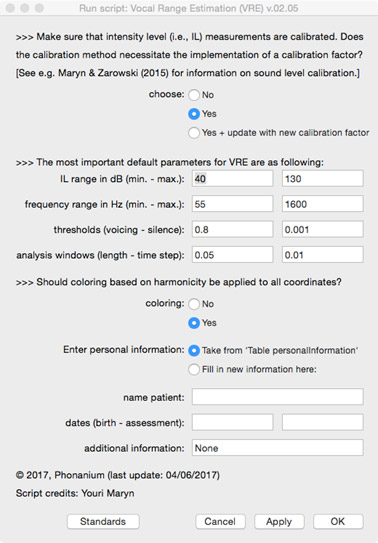Description
Vocal range estimation (v.02.06)
Vocal range estimation (VRE), also known as voice range profile or phonetogram, is one of the most commonly used methods in clinical voice sound assessment. With the PHONANIUM script for measuring and showing vocal range estimation in the program Praat, all relevant aspects and statistics regarding vocal range can easily be obtained for different voice/speech tasks.
Author of the Vocal range estimation VRE v.02.06 script
Youri Maryn
Included in this download
- Access to tutorial video with concise theory and illustration(s) on how to work with this Vocal range estimation script
- Access to tutorial video with concise theory and illustration(s) on how to calibrate intensity level measurements
- Access to tutorial video with concise theory and illustration(s) on how to evaluate the quality of sound recordings
- Access to tutorial video on how to work with the Personal information – New file script
- Access to tutorial video on how to implement/install plug-ins in the program Praat
- This plug-in
Plug-in details
Name of plug-in
plugin_PHONANIUM_VocalRangeEstimation_v.02.06
Content of plug-in
- Vocal range estimation VRE v.02.06.praat: to measure and show vocal range estimation with PHONANIUM’s script in the program Praat.
- setup.praat: to couple this script to a button in the dynamic menu of the program Praat.
- calibrationParameters.Table: a table in which previously and currently entered calibration data are stored. The last data set is used for calibration of the intensity levels measured in this script.
How to install this plug-in?
First, make sure to have downloaded and installed the program Praat (free available at www.praat.org) on your computer. Than download this plug-in.
Once downloaded, unzip the folder entitled plugin_PHONANIUM_VocalRangeEstimation_v.02.06 and place it in the following directory (i.e., the preferences directory of the program Praat), depending on your computer operating system and the name of the user (for example ‘Emiel’):
- Windows (Vista or later): C:\Users\Emiel\Praat\.
- Mac OSX: /Users/Emiel/Library/Preferences/Praat Prefs/. (However, sometimes the Library folder is hidden on a Mac OSX. If this is the case, you first open Finder, select the Go menu, and then press the alt key ⌥. While pressing the alt key ⌥, the Library becomes available as an option in the Go menu and can then be clicked/opened.)
- Linux: /UserName/.praat-dir/.
What is vocal range estimation?
Vocal range estimation (VRE) refers (a) to the display of a graph with vocal fundamental frequency (vocal fo) in logarithmic Hz on the abscissa (x-axis) and vocal intensity level (vocal IL) in calibrated or uncalibrated dB on the ordinate (y-axis), and (b) to the measurements of the minima, the maxima and the ranges in these two variables. In the VRE-graph, every coordinate (or dot) resembles one simultaneous measurement of vocal fo and vocal IL. This graph is also known as ‘voice profile’, ‘phonogram’, ‘phonetogram’ or ‘voice range profile’. It combines glottal adjustment capacity with driving pressure in a single chart. Because clinical circumstances not always stimulate the subject to use his/her voice at its complete potential (due to personal, spatial, motivational or other issues), the output of this method is considered to be merely an approximation of the true vocal capacities. It is therefore called vocal range estimation.
What influences vocal range estimation?
According to Baken & Orlikoff (2000), graph and estimates of vocal range are under the influence of numerous procedural factors such as: mouth-to-microphone distance, vowel type, stimulus (model) frequencies, intensity level measurement, administration (manual versus automated), axis scales, signal processing, fundamental frequency detection algorithm, etc. There are also subject-related factors: age, gender, training, voice quality, vocal register, etc. Consult for example Heylen et al. (1996) and Baken & Orlikoff (2000) for extensive reviews and test procedure guidelines on phonetography (or voice range profiling).
Vocal range estimation as treatment outcomes measure
Vocal ranges between highest and lowest possible fundamental frequencies and intensity levels shrink in persons with a voice disorders. This has been demonstrated in children as well as adults with various organic and non-organic voice disorders (Ikeda et al., 1999; Heylen et al., 2002). Furthermore, increase in vocal range across voice therapy in patients with diverse voice disorders has been shown by, e.g., Gramming (1988) and Speyer et al. (2003). As indication of vocal fold control and capacity, it is thus important to measure and follow up on these vocal ranges. As such, vocal range estimation is an asset in documenting an individual’s voice and in tracking outcomes of voice treatment. With PHONANIUM’s script for vocal range estimation in the program Praat, several descriptive statistics (i.e., minimum, maximum, and range) of vocal fundamental frequency and vocal intensity level become readily and rapidly available, as well as graphs showing their HNR-coloured coordinates and absolute distributions. All this information can be collected on whatever speech task the clinician intends to analyze: steadily sustained vowel, spontaneous speech, read text, gliding tones, singing, diadochokinetic syllable repetitions, etc. As such, vocal range estimation can be done for speaking voice (e.g., Titze et al., 2003) as well as singing voice (e.g., Lamarche et al., 2010).

Phonanium’s script for vocal fundamental frequency: specific features
Pre-analysis functions and formatting

Before analyzing the voice/speech signal, the user is prompted in a form:
- to choose if an intensity level calibration factor is to be implemented, and if yes, which dB scale was used during the calibration procedure;
- to specify the following parameters: measurement range in intensity level, measurement range in fundamental frequency, silence threshold, voicing threshold, and length and time step of the analysis windows;
- to enter personal information (i.e., name, date of birth, date of assessment and additional information) directly in this form, or to take this information after having it entered in the form of the PHONANIUM script entitled ‘Personal information’.
Graphical information output
- three-dimensional vocal range estimation plot (a.k.a. phonetogram or vocal range profile): logarithmic fundamental frequency on abscissa, intensity level on ordinate, and voice quality (or hoarseness, or dysphonia) on a color scale based on Praat’s harmonics-to-noise ratio (HNR).
- Histogram of distribution of vocal fo across all signals in the VRE analysis.
- Histogram of distribution of vocal intensity level across all signals in the VRE analysis.
Numerical/statistical information output
- Minimum vocal fo, in Hz as well as semitone (relative to 1 Hz)
- Maximum vocal fo, in Hz as well as semitone (relative to 1 Hz)
- Range in vocal fo, in Hz as well as semitone (relative to 1 Hz)
- Minimum vocal intensity level
- Maximum vocal intensity level
- Range in vocal intensity level
Important: calibration of vocal intensity level measurement
For clinical measurements of vocal intensity levels in the vocal range estimation to be reliable, it is essential to be calibrated before recording and analyzing sound signals (Ma, 2011). A straightforward method for calibration of the vocal intensity level has been described and found feasible, valid and accurate by Maryn & Zarowski (2016). This script automatically calibrates your intensity level measures when these data have been implemented/completed.
Click here to visit PHONANIUM’s page on vocal intensity level calibration.
Important: quality of sound recording
Many of the acoustic analyses and clinically relevant voice markers in the scripts of PHONANIUM imply sophisticated and complex procedures. However, when they are run on signals with bad recording quality, they loose their clinical value in terms of validity and reliability. So, prior to undertaking high-standard acoustic voice analyses, clinicians have to make well-considered choices in all of the following elements in the audio recording chain: room acoustics and ambient noise, type and placement of microphone, microphone preamplifier, and digital audio capturing device. To sample all relevant vocalizations and speech tokens as least polluted by recording-related noise as possible is what it essentially comes down to. For example Maryn (2017) offers an overview on how to deal with this.
Click here to visit PHONANIUM’s page on how to minimize recording-related influences on voice/speech signals.
Important: use the ‘Personal information’ script
With the script ‘Personal information v.01.02’ the user can complete an electronic form with the subject’s/patient’s name, date of birth, date of assessment, and optionally extra information. All this information (a) is than written into a table, (b) will be consulted by the other PHONANIUM scripts if the option “Take from ‘Table personalInformation’” is selected, and (c) will be written automatically in the output of these scripts. This increases the user-friendliness of working with PHONANIUM scripts in the program Praat, as the user/clinician has to complete this personal information only once during the entire voice assessment session.
Click here to visit PHONANIUM’s page on this ‘Personal information v.01.02’ script.
Disclaimer
For customers in the EU: this software currently has no CE certification. We are in the process of application. In the meantime, this software can be used for scientific as well as educational/learning purposes.
Program Praat
Click here to visit the website where the program Praat (Paul Boersma & David Weenink, Institute for Phonetic Sciences, University of Amsterdam, The Netherlands) can be downloaded. This software runs under the GNU General Public License. Click here to download this license.
References
Baken RJ, Orlikoff RF (2000). Clinical measurement of speech and voice. San Diego, CA: Singular Publishing Group.
Gramming P (1988). The phonetogram: an experimental and clinical study [PhD dissertation]. Malmö, Sweden: University of Lund.
Heylen LG, Wuyts FL, Mertens FW, Pattyn JE (1996). Phonetography in voice diagnoses. Acta Otorhinolaryngologica Belgica, 50, 299-308.
Ikeda Y, Masuda T, Manako H, Yamashita H, Yamamoto T, Komiyama S (1999). Quantitative evaluation of the voice range profile in patients with voice disorder. European Archives of Oto-Rhino-Laryngology, 256, S51-S55.
Lamarche A, Ternström S, Pabon P (2010). The singer’s voice range profile: female professional opera soloists. Journal of Voice, 24, 410-426.
Ma EP-M (2011). Voice range profile: Phog. In Ma EP-M, Yiu EM-L (editors): Handbook of voice asessments, 253-267. San Diego, CA: Plural Publishing.
Maryn Y, Zarowski A (2015). Calibration of clinical audio recording and analysis systems for sound intensity measurement. American Journal of Speech-Language Pathology, 24, 608-618.
Maryn Y (2017). Practical acoustics in clinical voice assessment: a Praat primer. Perspectives of the ASHA Special Interest Groups, SIG3, 2, Part 1.
Speyer R, Wieneke GH, van Wijck-Warnaar I, Dejonckere PH (2003). Effects of voice therapy on the voice range profiles of dysphonic patients. Journal of Voice, 17, 544-556.
Titze IR, JG Švec, Popolo PS (2003). Vocal dose measures: quantifying accumulated vibration exposure in vocal fold tissues. Journal of Speech, Language, and Hearing Research, 6, 919–932.
Wuyts FL, Heylen L, Mertens F, Du Caju M, Rooman R, Van De Heyning PH, De Bodt M (2003). Effects of age, sex, and disorder on voice range profile characteristics of 230 children. Annals of Otology, Rhinology, and Laryngology, 112, 540-548.
Additional reading on vocal range estimation or phonetography
Coleman RF (1993). Sources of variation in phonetograms. Journal of Voice, 7, 1-14.
Heylen L (1997). De klinische relevantie van het fonetogram: een onderzoek bij kinderen en leerkrachten [The clinical relevance of the phonetogram: an investigation in children and teachers; PhD dissertation]. Antwerp, Belgium: University of Antwerp.
Ma EP-M, Yiu EM-L (2011). Handbook of voice assessments. San Diego, CA: Plural Publishing.
Updates
Vocal range estimation (v.02.06), 27/01/2019
- Addition of a free field for the gender entry under ‘personal information’, to account for issues related to gender diversity.










Reviews
There are no reviews yet.